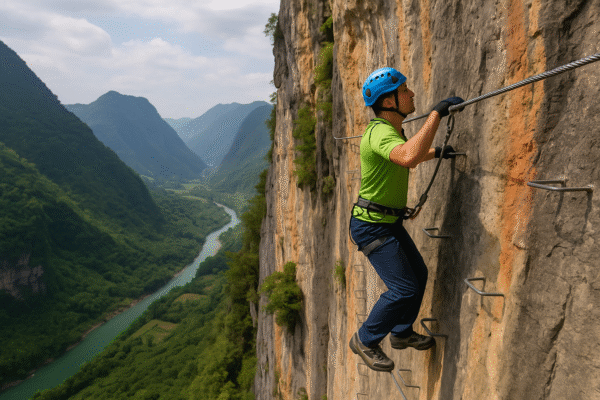Enshi, a once-isolated mountainous region in China’s Hubei Province, is rapidly transforming into a vibrant hub for adventure tourism. At the heart of this economic revival is via ferrata, a thrilling climbing experience that has taken root in the region’s dramatic karst terrain. Meaning “iron path” in Italian, via ferrata involves ascending steep rock faces using steel cables, ladders, and footholds securely anchored into the rock—a sport that combines adrenaline with breathtaking views.
This European-imported climbing trend is now reshaping the socio-economic landscape of Enshi Tujia and Miao Autonomous Prefecture, turning once-overlooked rural communities into thriving tourism hotspots.
Jigongling and Qingjiang: The Climbers’ New Frontier
One of Enshi’s most popular via ferrata routes lies on Jigongling Mountain, located in Huaping Township. Since its opening in 2017, this 2.8-kilometer route with a 650-meter vertical drop has attracted over 30,000 climbers in 2024 alone, according to local tourism authorities. The route offers panoramic views of misty valleys, lush forests, and steep cliffs—an Instagram-worthy combination for outdoor enthusiasts.
Another recent addition is the Qingjiang River via ferrata, which opened in May 2025. In just two months, this family-friendly route has welcomed over 1,000 climbers, including both seasoned adventurers and first-time visitors. The surge in traffic has not only elevated Enshi’s visibility on China’s domestic travel radar but also started drawing international tourists in search of authentic, off-the-beaten-path experiences.
Rural Revitalization Through Tourism
Before the tourism boom, Huaping Township’s remote altitude of 1,200 meters made it one of the economically disadvantaged areas of Hubei Province. Residents mostly relied on subsistence agriculture—growing corn and potatoes—with limited access to broader markets or economic opportunity. But via ferrata tourism has reversed that narrative.
Young locals who previously migrated to cities for work have returned home to become certified climbing instructors, earning between 7,000–8,000 yuan per month (approximately USD $975–$1,115). Over 150 new jobs have been created across sectors such as hospitality, transport, equipment rentals, and guided tours—injecting new life into the local economy.
Small Businesses Thrive with Entrepreneurial Spirit
The wave of tourism has ignited an entrepreneurial boom. Local farmers have converted their traditional homes into guesthouses, offering comfortable accommodations with scenic views and traditional hospitality. One such homeowner now hosts over 3,000 tourists annually, generating upwards of 100,000 yuan (USD $13,900) in revenue—a major leap from former farming incomes.
These guesthouses are complemented by a surge in local restaurants and specialty shops, selling Enshi’s famous preserved meats, herbal teas, and handmade crafts. With tourists eager to sample authentic local flavors, food tourism has become an essential part of the adventure experience.
Agricultural Boost and Sustainability Integration
Via ferrata tourism is also positively impacting Enshi’s agricultural landscape. For example, grape growers near Jigongling Mountain—once unable to sell their produce—have reported a 40% increase in grape sales due to tourist demand. The climb often ends with a refreshing visit to local fruit farms, where climbers can pick and purchase produce directly from growers.
Moreover, with increased attention on environmental sustainability, Enshi’s local government has encouraged the adoption of eco-friendly farming practices, aligning with China’s broader goals for rural revitalization and green tourism, as outlined in the national “Beautiful Countryside” initiative by the Ministry of Agriculture and Rural Affairs.
Adventure Tourism as a Blueprint for Rural China
The rise of via ferrata in Enshi is not just a success story for one region—it offers a model for sustainable rural development across China. By leveraging natural landscapes and cultural heritage, previously underserved areas can tap into the fast-growing demand for experiential, adventure-based tourism.
According to China’s Ministry of Culture and Tourism, adventure tourism is expected to grow by over 20% annually in the next five years, particularly among younger domestic travelers seeking more immersive and active travel experiences. Enshi’s positioning as a climbing paradise and eco-destination aligns perfectly with this national trend.
A Climb Toward Prosperity
Today, Enshi stands as a shining example of how tourism—when built on sustainable principles and local involvement—can uplift entire communities. From young climbing guides to grape farmers and guesthouse owners, the economic benefits are widely shared, and the region’s future is brighter than ever.
The rugged karst peaks that once symbolized Enshi’s geographic isolation are now its greatest assets, drawing thousands in search of excitement, connection with nature, and local hospitality. Each new climber is not just scaling a cliff—but helping elevate a region.
Plan your next adventure in Enshi—where the cliffs are high, the views unforgettable, and the economic impact life-changing.
For more travel news like this, keep reading Global Travel Wire



















